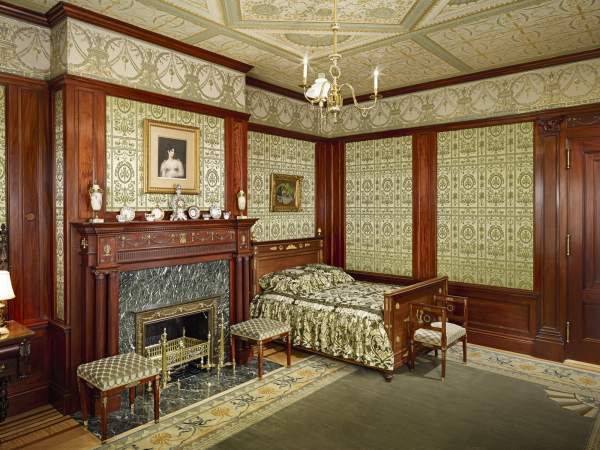By Pabst Mansion
The Pabst Mansion has been able to thrive because of the restoration that the Pabst Mansion organization continues to do to keep this historic building in proper condition. While maintenance and restoration needs are ever present, continued efforts help keep this historic building in the community and allow younger people to experience something of the past in Milwaukee. It became apparent that the Mansion walls were starting to deteriorate with holes in the terracotta and leaks were starting in the roof in 1979, almost a year after saving it from demolition. It was decided that the whole exterior would be secured, and the original spires would be replicated and replaced.

Spray-O-Bond installs the recreated spires on the Pabst Mansion’s front elevation
The original spires had been removed in 1918 from the Mansion’s gables. This mission was given a high priority, and everybody was driven to return the lost architectural elements to the Mansion’s facade. The $1.2 million multiphase mission of restoring the Mansion’s exterior to its former glory was known as the Serpent and Spires Capital Campaign, because they were mainly fixing the spires and serpent downspout that had been destroyed.
Repairing the roof was a long and a painful process, as the intent was to leave as much of the original roof as possible with the addition of replacement copper flashing. Next, they had to figure out how to repair the terracotta exterior that was causing concern. Spray-O-Bond, a local Milwaukee historic restoration business, was tasked with designing new terracotta molds from the original pictures and reinstalling them. Large blocks of terracotta ornaments were taken off the property for the first time since 1891. They were then shipped to Buffalo, New York to have replacements made at Boston Valley Terra Cotta Company, one of the only major terracotta companies left in the United States. All that was left was the essential replicants of the spires to complete the original image of the exterior of the Mansion. H. Russell Zimmerman would be put in charge of designing the new terracotta spires and serpent downspout that had been previously damaged beyond repair. It took a lot of work and time, but he was successful in his mission and now the exterior was brought back to its original design. It would not be until a few years later that the restoration process moved to the interior of the Mansion.

The Regency Room after it had been fully restored
The Regency Room, AKA Emma’s Room, was another restoration process undertaken at the Pabst Mansion – this time in the interior. The room defines the English Regency era when George IV was acting as the Prince Regent in the United Kingdom because it includes elaborately painted friezes by the ceiling, walls covered in lavish silks, classical anthemion and decorative festoons, and a hand-knotted rug that brings the whole room together.

The removal of white paint revealed the origial green palette underneath
The work was not completed until about a decade ago and represents only one of the many projects restoring the interior of the Mansion to its former design. The room was by no means an easy process to restore because of its luxurious design. The silk wall coverings were recreated by Scalmandre using original photos of the Pabst Mansion in 1897. The wool rug in the room was recreated thanks to William Ferry, the grandson of the Pabst Mansion’s original architect. The rug has an incredible 2.1 million knots and was produced in Nepal. Not only was the bedroom saved in this restoration process, but also the adjoining bathroom. It was able to be restored thanks to the only authentic bathtub from the Pabst Mansion which had stored in the basement for decades. I am glad to see it finally got its chance to shine instead of being stuck in a basement or even destroyed.

A mock-up of the recreated rug using an original photo of Emma’s Room from 1897
Overall, the Pabst Mansion has received millions of dollars for restoration and upkeep and thanks to these efforts the Mansion is one of the best house museums in America. Although it is an old building with indefinable upkeep, it serves as a reminder of Milwaukee’s past and is important to protect and continually preserve. I know that Captain and Mrs. Pabst and their descendants would be proud of all the people that have helped preserve this historic building over the years and hopefully many more in the future.
Written by Will McClure

